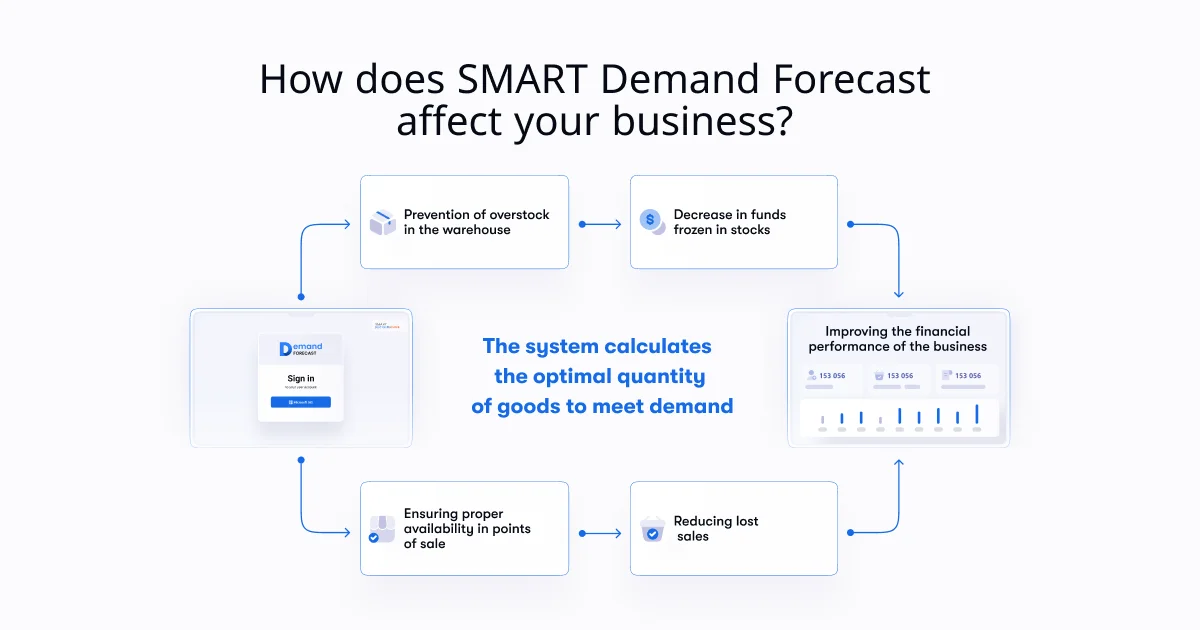14 Jan 2025 10 MIN READ
Is your company ready for breakthrough changes? Artificial Intelligence as a key aspect of the present

After the release of the public version of Chat GPT in November 2022, which gained a million users in less than a week and is becoming more and more popular every day, traditionally most people identify it with AI (Artificial Intelligence).
However, AI is a much broader concept than even those cognitive services that Chat GPT includes. In particular, this is machine learning, computer vision, language recognition and data analysis.
If we consider cognitive services, then by the level of their application we have the following distribution: voice recognition (25%); sentiment analysis (10%); image recognition (20%); personalization (10%); natural language processing – NLP (35%).
AI, without exaggeration, opens up unlimited opportunities for business. Here are just some of the benefits that a company receives after its implementation: improved interaction with clients; increased operational efficiency; a new level of precision in the management decision-making process; increased security of information systems. And in recent years, innovative products and services based on AI have been created.
Each company chooses its own “set of smart solutions” based on specific needs. However, in any case, business transformation with AI begins with investments in data collection and analysis technologies, which are the basis for the implementation of more complex algorithms and solutions.
So, if you said “yes” to modernizing business processes, you should think about choosing an ERP solution. It is important to remember that ERP plays a key role in processing and integrating data from all processes of the organization, including those with which AI will work for the benefit of your business. Therefore, the degree of trust in it is critical both within the company and among partners and investors.
For example, solutions from SMART business, a leading Microsoft partner, meet international standards and provide automation of business processes with the ability to easily control and audit them. At the same time, they are flexibly customized to the most unexpected needs of each specific business and are quickly implemented. And thanks to the integration of real-time analytics and artificial intelligence capabilities into the system, they are a convenient and reliable tool for top management to plan and distribute resources, as well as monitor efficiency – both of individual business processes and the business as a whole.
If we talk about the most common areas of AI applicability, we get an extremely wide list:
- Customer service is in the lead. More and more companies from all over the world trust AI to provide a high level of service. Various recommendation systems operate on its basis, using the analysis of previous consumer preferences to generate advice on improving their satisfaction; chatbots and virtual assistants that answer frequently asked customer questions 24/7. According to a McKinsey study, in North America, about half of customer requests in the banking, telecommunications and software companies are closed by machines, including those based on AI. While employees can focus on solving service issues that require more thorough processing by a specialist.
- In supply chain management, in particular for demand forecasting and in logistics, for optimizing delivery routes.
- In marketing for creating personalized advertising, that is, the most relevant offers and advertisements for a specific consumer.
- In financial analysis – to improve credit risk analysis and identify fraudulent activities with a high degree of accuracy. In particular, with AI, financial institutions can automate the process of assessing creditworthiness of clients and instantly identify suspicious transactions, reducing risks and minimizing possible losses.
- In healthcare – to diagnose diseases. The experience of PathAI, a company that creates technologies based on machine learning for analyzing tissue samples for pathology, is interesting. And pharmacists from Atomwise use deep learning technologies to speed up the process of inventing new drugs. Here, AI analyzes billions of possible chemical compounds in search of promising areas for research.
- In manufacturing – to automate production lines, predict inventory needs and optimize the workflow.
- To protect against “phone pranksters”. For example, Motorola Solutions specialists use AI to recognize voice commands and transcribe calls to the 911 service in real time. This helps to provide the necessary information faster and more accurately in crisis situations by filtering out “phone pranksters”. It is based on an accurate assessment of the emotional state of callers
- In HR and recruiting – for CV analysis, forecasting potential candidates for vacancies, conducting initial interviews and reskilling and upskilling of personnel. For example, the educational technology company Skillsoft has developed Conversation AI Simulator (CAISY). The program allows users to practice conducting business discussions, acquire skills in providing business proposals, and resolving conflict situations in the process of customer service.
IT ecosystem of AI-based solutions from SMART business
It is obvious that at the current stage of technological development, investments in AI are investments in your own competitiveness in the short term. Thus, according to a McKinsey study, how actively retailers will implement AI-based technologies in the next 2-3 years will determine their success for at least two decades to come.
So how can a business adapt to these changes and reach such a level of efficiency so as not to constantly catch up, but to grow steadily? Where to start your own smart transformation story?
Experts in the field of predictive analytics recommend starting with an audit of your own business needs and an assessment of resources.
You should “diagnose” pain points – be it inaccurate demand forecasting during peak season or slip-ups in setting promotional prices; ineffective promotions or difficulties with uniform staff workload… However, do not rush to blame your own analysts, marketers or HR specialists for these gaps. Delegate the routine of data analysis to AI and give your staff room for creativity and the opportunity to focus on strategic tasks.
 Artem Stepanov SMART Demand Forecast Product Owner
Artem Stepanov SMART Demand Forecast Product Owner
The next step is to choose a solution for your own tasks from a wide range of tools available on the market. This stage involves a detailed analysis of not only the functionality of the solutions, but also the availability of technical and service support, capabilities for scalability and integration with existing systems. In this context, innovative solutions based on Microsoft technologies stand out. For example, let’s consider a pool of AI-based products from the SMART business team:
- SMART Demand Forecast is a demand forecasting system based on machine learning and AI. Provides comprehensive forecasting for regular and promotional sales at different levels of granularity.
- SMART Price Insights is an AI-based pricing solution that fully automates the pricing process and creates a single space for price management. Thanks to dynamic pricing, you can always meet market demands, and an adaptive strategy settings system will allow you to quickly and effectively respond to business challenges.
- SMART Personal Engagement is a system for optimizing marketing processes and personal interaction with clients. It is a kind of target audience designer. It allows you to segment huge amounts of client data and personalize advertising campaigns. An indispensable assistant when it comes to finding the optimal communication strategy.
- SMART Flexi Scheduler is a workforce management system for flexible management of teams’ working hours. AI algorithms analyze historical data and predict future needs, ensuring efficient use of personnel and reducing costs. The solution allows you to accurately predict the need to attract personnel (taking into account qualification requirements and restrictions).
An integrated approach to building a unified IT ecosystem based on Microsoft technologies, customized services and artificial intelligence allows companies to quickly respond to changes, improve the efficiency of business processes and quickly scale.
SMART Demand Forecast – your “sixth sense” in building forecasts
And yet, the most convincing language for business is the language of numbers. Let’s consider a real case of implementing SMART Demand Forecast in the McDonald’s restaurant chain in Georgia.
Today, the chain has 23 restaurants. Every day, one and a half thousand employees serve about 35 thousand visitors. And at the same time, they adhere to the highest standards. Of course, in such conditions, you can’t do without serious predictive analytics built on innovative technologies. And at McDonald’s Georgia, they have been using it for a long time.
However, the company previously used a solution that allowed for demand forecasting at the level of the entire chain for three months with aggregation at the level of each month. Such a wide forecasting interval did not allow for short-term changes in demand to be taken into account. In particular, its dependence on seasonal fluctuations or various local events. Also, the accuracy of forecasts was reduced by the fact that demand was forecast for the entire chain and the forecast did not reflect the real picture in terms of individual restaurants.
Accordingly, due to the high expertise of the SMART business team, its specialists were asked to offer a solution that was more relevant to the situation.
The implementation of the SMART Demand Forecast solution allowed for demand forecasting with aggregation up to the weekly level and with granulation by product and end restaurant. At the same time, the consistency of data and forecasts across the entire restaurant chain was ensured to avoid discrepancies and errors.
As a result of implementing SMART Demand Forecast, it was possible to achieve:
- 83% accuracy of sales forecasting for each restaurant based on weekly data aggregation for a period of 4 weeks,
- 80% accuracy of sales forecasting for each restaurant based on weekly data aggregation for a period of 12 weeks,
- Deviations on average up to 5% from forecast fulfillment, which is the norm among the global business community.
Therefore, the company was able to optimize the demand forecasting process and, as a result, inventory management, as well as increase customer satisfaction and significantly reduce operating costs.
This allowed the staff of the McDonald’s restaurant chain in Georgia to focus on creating a unique customer experience for each consumer to increase brand loyalty.
What you need to know about SMART Demand Forecast
The main advantages of SMART Demand Forecast, which businesses have already appreciated, are high-quality forecasting of both promotional and regular sales. One of the advantages of the solution is scenario forecasting. In fact, you can model different courses of promotions and understand what volume of goods can be sold by setting a particular price. And you will not have to risk your budget.
After implementing the solution, you will be able to:
- reduce the workload of cross-functional teams,
- reduce the amount of stock to the optimal level,
- improve the level of service due to more accurate response to consumer requests and ensuring a higher level of product availability,
- reduce the number of write-offs,
- make informed management decisions,
- quickly receive reports.

Calculate how the accuracy of forecasting will affect the profitability of your business here
Calculate the potential profit
